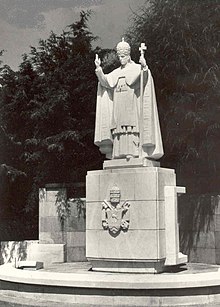
The Most Sacred Heart of Jesus is one of the most widely practised and well-known Catholic devotions, wherein the heart of Jesus Christ is viewed as a symbol of "God's boundless and passionate love for mankind". This devotion to Christ is predominantly used in the Catholic Church, followed by high-church Anglicans, and some Western Rite Orthodox. In the Latin Church, the liturgical Solemnity of the Most Sacred Heart of Jesus is celebrated the third Friday after Pentecost. The 12 promises of the Most Sacred Heart of Jesus are also extremely popular.

Our Lady of Fátima is a Catholic title of Mary, mother of Jesus, based on the Marian apparitions reported in 1917 by three shepherd children at the Cova da Iria in Fátima, Portugal. The three children were Lúcia dos Santos and her cousins Francisco and Jacinta Marto. José Alves Correia da Silva, Bishop of Leiria, declared the events worthy of belief on 13 October 1930.

The Scapular of Our Lady of Mount Carmel belongs to the habit of both the Carmelite Order and the Discalced Carmelite Order, both of which have Our Lady of Mount Carmel as their patroness. In its small form, it is widely popular within the Latin Church of the Catholic Church as a religious article and has probably served as the prototype of all the other devotional scapulars. The liturgical feast day of Our Lady of Mount Carmel, July 16, is popularly associated with the devotion of the Scapular.

The Feast of the Sacred Heart is a feast day in the liturgical calendar of the Roman Rite of the Catholic Church. According to the General Roman Calendar since 1969, it is formally known as the Solemnity of the Most Sacred Heart of Jesus and falls on the Friday that follows the second Sunday after Pentecost, which is also the Friday after the former octave of Corpus Christi. Some Anglican Franciscans keep the feast under the name of the Divine Compassion of Christ.
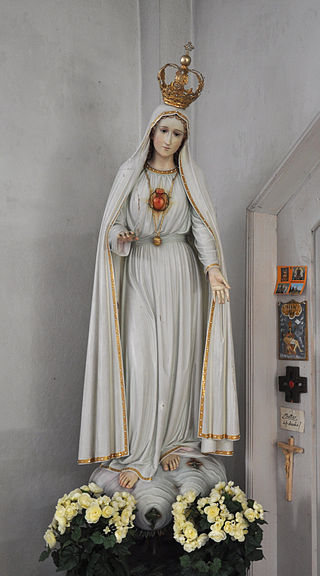
The consecration of Russia to the Immaculate Heart of Mary by a reigning pope was requested during a Marian apparition by Our Lady of Fátima on 13 July 1917, according to Lúcia dos Santos, one of the three visionaries who claimed to have seen the apparition. Sister Lucia said that at different times the Blessed Virgin Mary had given her a message of promise that the consecration of Russia to the Immaculate Heart of Mary would usher in a period of world peace.
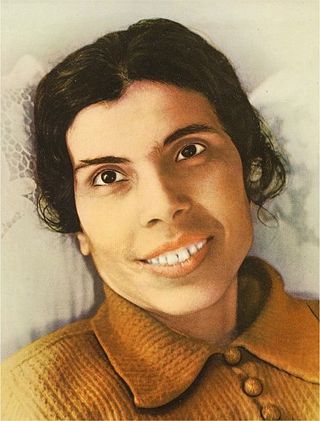
Alexandrina Maria da Costa, best known as Blessed Alexandrina of Balazar, was a Portuguese mystic and victim soul, member of the Association of Salesian Cooperators, who was born and died in Balazar. On 25 April 2004, she was declared blessed by Pope John Paul II who stated that "her secret to holiness was love for Christ".

Our Lady of Aparecida, is a title of the Blessed Virgin Mary associated with the Immaculate Conception.

Catholic devotions are particular customs, rituals, and practices of worship of God or honour of the saints which are in addition to the liturgy of the Catholic Church. The United States Conference of Catholic Bishops describes devotions as "expressions of love and fidelity that arise from the intersection of one's own faith, culture and the Gospel of Jesus Christ". Devotions are not considered part of liturgical worship, even if they are performed in a church or led by a priest, but rather they are paraliturgical. The Congregation for Divine Worship at the Vatican publishes a Directory on Popular Piety and the Liturgy.

The Marian Movement of Priests (MMP) is a private association of Catholic clergy and lay associate members founded by Italian priest Fr. Stefano Gobbi in 1972. According to the MMP, its members now include over 400 Catholic cardinals and bishops, more than 100,000 Catholic priests, and several million lay Catholics worldwide.
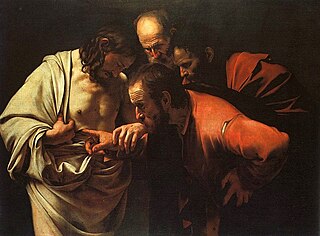
A number of people have claimed to have had visions of Jesus Christ and personal conversations with him. Some people make similar claims regarding his mother, Mary. Discussions about the authenticity of these visions have often invited controversy. The Catholic Church endorses a fraction of these claims, and various visionaries it accepts have achieved beatification, or even sainthood.

Throughout history, Catholic Mariology has been influenced by a number of saints who have attested to the central role of Mary in God's plan of salvation. The analysis of Early Church Fathers continues to be reflected in modern encyclicals. Irenaeus vigorously defended the title of "Theotokos" or Mother of God. The views of Anthony of Padua, Robert Bellarmine and others supported the doctrine of the Immaculate Conception of the Virgin Mary, which was declared a dogma in 1850.

The Mariology of the popes is the theological study of the influence that the popes have had on the development, formulation and transformation of the Roman Catholic Church's doctrines and devotions relating to the Blessed Virgin Mary.

The veneration of Mary in the Catholic Church encompasses various devotions which include prayer, pious acts, visual arts, poetry, and music devoted to her. Popes have encouraged it, while also taking steps to reform some manifestations of it. The Holy See has insisted on the importance of distinguishing "true from false devotion, and authentic doctrine from its deformations by excess or defect". There are significantly more titles, feasts, and venerative Marian practices among Roman Catholics than in other Western Christian traditions. The term hyperdulia indicates the special veneration due to Mary, greater than the ordinary dulia for other saints, but utterly unlike the latria due only to God.

A Marian year is a designation given by the Catholic Church to calendar years in which Mary the mother of Jesus is to be particularly reverenced and celebrated. Marian years do not follow a set pattern; they may be declared by a bishop for his diocese, or a national conference of bishops for a country.

Pope Pius XII consecration of the world to the Immaculate Heart of Mary took place on October 31, 1942. Pope Pius XII performed a Marian consecration, entrusting the world to the Virgin Mary, as Queen of Peace, through her Immaculate Heart.

Catholic Marian movements and societies have developed from the veneration of the Blessed Virgin Mary by members of the Catholic Church. These societies form part of the fabric of Mariology in the Catholic Church. Popular membership in Marian organizations grew significantly in the 20th century, as apparitions such as Our Lady of Fátima gave rise to societies with millions of members, and today many Marian societies exist around the world. This article reviews the major Marian movements and organizations.
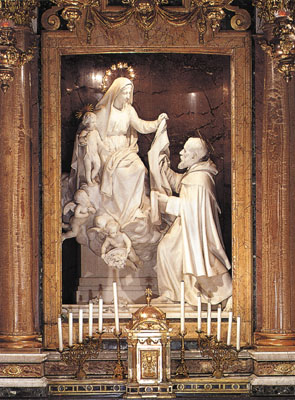
The exact origins of both the rosary and scapular are subject to debate among scholars. Pious tradition maintains that both the rosary and the brown Scapular of Our Lady of Mount Carmel were given by the Virgin Mary to Dominic and Simon Stock respectively during the 13th century. Historical records document their growth during the 16th and 17th centuries in Europe. By the early 20th century, they had gained such a strong following among Catholics worldwide that Josef Hilgers, writing in the Catholic Encyclopedia of 1914, stated: "Like the Rosary, the Brown scapular has become the badge of the devout Catholic."

The Scapular of the Sacred Heart is a Roman Catholic devotional scapular bearing an image of the Sacred Heart of Jesus on the front panel, and an image of the Virgin Mary as Mother of Mercy on the panel which hangs at the wearer's back. In its current form, the design and the formal church approval for its use are due to Estelle Faguette, a French domestic servant, who in 1876 claimed to have received a series of apparitions during which the Virgin Mary showed this scapular and spoke about its use.

The "Alliance of the Hearts of Jesus and Mary" is a phrase coined by Pope John Paul II during his Angelus Address of September 15, 1985. Discussing devotion to the Sacred Heart of Jesus and the Immaculate Heart of Mary, he said that "...though distinct, they are interrelated by reason of the enduring relation of love that exists between the Son and his Mother." Subsequently, several symposia were held to examine its roots and implications. Since there had already been much research on Devotion to the Sacred Heart, the conferences tended to focus on the devotion to the Immaculate Heart of Mary from the perspective of Sacred Scripture and Tradition.

The consecration and entrustment to the Virgin Mary is a personal or collective act of Marian devotion among Catholics, with the Latin terms oblatio, servitus, commendatio and dedicatio being used in this context. Consecration is an act by which a person is dedicated to a sacred service, or an act which separates an object, location or region from a common and profane mode to one for sacred use. The Congregation for Divine Worship and the Discipline of the Sacraments clarifies that in this context, "It should be recalled, however, that the term "consecration" is used here in a broad and non-technical sense: the expression is use of 'consecrating children to Our Lady', by which is intended placing children under her protection and asking her maternal blessing for them".




